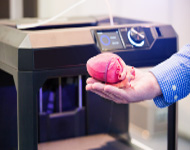 3D printing is a process of creating three-dimensional models from a digital file. This manufacturing technique has been very beneficial to various industries nowadays including the medical field.
3D printing is a process of creating three-dimensional models from a digital file. This manufacturing technique has been very beneficial to various industries nowadays including the medical field.
3D printing has been playing an important role to rapidly produce and customise 3D printed medical devices and tools. To give you better understanding on this, here is a blog post on how 3D printing is revolutionising the medical industry.
Advantages of 3D printing in medical industry
3D printing enables doctors to work faster and improve medical operation results. Below are other advantages of 3D printing in the healthcare industry.
1. Customisation
One of the greatest advantages of using 3D printing in the medical industry is the freedom to customise medical products and equipment. Products such as implants and prosthetics can provide great assistance for both physicians and patients.
2. Cost-efficient
Most of the resources used by surgeries or to treat patients are often expensive. Thus, biomedical engineers are now utilising 3D printing technology to provide affordable solutions to patients.
With 3D printing, inexpensive medical items can be produced easily. Although traditional manufacturing is still beneficial for large-scale production, 3D printing is more competitive when it comes to small production runs.
For instance, a patient may only need a customised small-sized implant or prosthetic. Using 3D printing can be advantageous since you can create inexpensive parts in a shorter period of time.
3. Enhanced productivity
Compared to traditional manufacturing, 3D printing can produce medical items faster. Apart from that, 3D printed medical objects/tools are more reliable, accurate and have high resolution and quality.4. Innovative
Since the process of producing new medical products is now easier and cost-efficient, medical researchers and professionals can develop new innovations in the medical field.
For example, 3D printing is used today to create organoids and mini-models of a human body. These products are used to treat cancer by testing patient tumours’ cells and see how it responds to certain medicines.
Uses of 3D printing in medical industry
From the advantages of 3D printing in the medical industry mentioned above, here are some of the 3D printing relevant uses in the medical field.
1. Rapid prototyping
Rapid prototyping allows biomedical engineers to produce medical tools and models in a short period of time. Prototypes are also created to test functional parts of certain medical devices.
2. Realistic anatomical models
3D printed medical tools and devices are used as models for medical marketing and education. Moreover,3d printing produces accurate models of anatomy and medical devices. These models can also be easily modified to solve specific problems of patients and doctors.
3. Patient-specific solutions
The situation of each patient can be different. Thus, 3D printing is used to create patient-specific implants and prosthetics. It is also used to create organ replicas so that surgeons can practice before performing complicated operations.
Medical applications of 3D printing
3D printing has been very valuable for the medical industry for the past few years. Here are some of the applications of 3D printing in the medical industry.
-
Bioprinting tissues and organs
Bioprinting is a process of using biomaterials such as cells to create tissue-like structures for reconstructive surgery. Rather than using plastic or metal materials for printing, these biomaterials are used as “inks” to produce new biological structures.
This technique has the potential to repair damaged organs, tissues and cells in human’s body. For instance, skin cell bioprinting is being developed today for patients who have skin-related disease. Bioprinting is also used to mimic human organs on a miniature scale for research purposes.
-
Implants and prostheses
3D printing has been used in the health sector to produce both simple and complex prosthetics as well as surgical implants. Apart from this, 3D printing can be used to produce customised prosthetic limbs that are suitable to a specific patient.
Moreover, amputees usually wait for weeks or months to receive their prosthetics. But with 3D printing, it will only take days or even hours to produce functional 3D-printed prosthetics. 3D printing can also offer cheaper products to patients but with the same functionality like the traditionally manufactured prosthetics.
-
3D printing surgical instruments
Biomedical engineers can now 3D print surgical tools such as forceps, haemostats, scalpel clamps, etc. Apart from that, they can produce very small yet precise instrument. These tools are also way cheaper than other medical instruments that are produced using traditional manufacturing methods.
-
Anatomical models for surgical purposes
The ability of 3D printing to produce complex models is beneficial for surgical preparation. Instead of relying solely on MRI and CT scans, doctors can use 3D printed models to study a patient’s anatomy before surgery. These models can also be used for surgical training or simulation.
This procedure has been proven to speed up surgeries and minimise trauma for patients. Advancements in the medical field also include 3D printing human organs such as heart, kidney and liver which are now being artificially produced for practical surgical use.
Conclusion
3D printing has become a beneficial process in various fields including the medical industry. Many health researchers are now utilising 3D printing to explore new medical applications and technologies.
Although these technologies are still evolving, 3D printing has great potential in the medical industry. If you would like to 3D print some medical parts, a 3D printing service provider can help you. They usually provide services to various industries including medical industry and can provide you with what you required (eg. 3d parts/components of medical equipment & other customised 3d printed parts)








